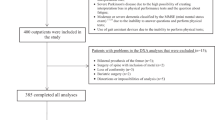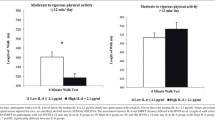Abstract
Objective
Metabolic and atherosclerotic diseases are known risk factors for disability in old age, and can result in sarcopenia as well as cognitive impairment, which are both components of frailty syndrome. As muscle loss increases with ageing, it is unclear whether muscle loss per se, or the diseases themselves, are the underlying cause of physical frailty in those suffering from these diseases. We tested the hypothesis that metabolic and atherosclerotic diseases and cognitive impairment are associated with physical frailty independent of muscle loss in old age, and further examined their impact on the relationship between physical frailty and mortality.
Design
Prospective.
Setting
Community.
Participants
4000 community dwelling Chinese elderly ≥65 years.
Measurements
Diabetes, hypertension, stroke, heart disease, cognitive impairment, smoking, physical activity, waist hip ratio (WHR) and ankle-brachial index (ABI)) were recorded. Physical frailty measurements (grip-strength, chair-stands, stride length and 6-metre walks) were summarized into a composite frailty score (0–20), 0 being the most frail) according to quartiles of performance. Appendicular muscle mass (ASM) was measured using dual X-ray absorptiometry. Relationships between the score and covariates were analyzed. Cox regression was used to study the impact of metabolic and atnerosclerotic risk factors on the relationship between physical frailty and 6-year mortality.
Results
After adjustment for ASM, all metabolic diseases and indexes, and cognitive impairment were significantly associated with the composite physical frailty score in univariate analysis. In multivariate analysis, cognitive impairment, high WHR, diabetes, stroke and heart disease were all independently associated with higher physical frailty with adjustment for age, physical activity level and ASM. Hypertension was associated with physical frailty in men but not in women. In Cox regression, increased physical frailty was associated with higher 6-year mortality. The impact of metabolic and atherosclerotic risk factors was however only modest after adjustment for age and cognitive function.
Conclusion
Metabolic and atherosclerotic diseases and high WHR, was associated with physical frailty, independent of their adverse effect on cognitive function and muscle mass.
Similar content being viewed by others
References
Miller DK, Lui LYL, Perry III HM, Kaiser FE, Morley JE. Reported and measured physical functioning in older inner-city diabetic African Americans. J Gerontol 1999;54A:M230–M236.
Blaum CS, Xue QL, Michelon E, Semba RD, Fried LP. The association between obesity and the frailty syndrome in older women: the Women’s Health and Aging Studies. J Am Geriatr Soc 2005;53(6):927–934.
Al Snih S, Ottenbacher KJ, Markides KS, Kuo Y-F, Eschbach K, Goodwin JS. The effect of obesity on disability vs mortality in older Americans. Arch Intern Med 2007;167:774–780.
Woo J, Leung J, Kwok T. BMI, body composition, and physical functioning in older adults. Obesity 2007;15:1886–1894.
Hubbard RE, Andrew MK, Fallah N, Rockwood K. Comparison of the prognostic importance of diagnosed diabetes, co-morbidity and frailty in older people. Diabet Med 2010;27, 603–606.
Park SW, Goodpaster BH, Lee JS, et al. for the Health, Aging, and Body Composition Study. Excessive loss of skeletal muscle mass in older adults with type 2 diabetes. Diabetes Care 2009;32:1993–1997.
Lee JSW, Auyeung TW, Leung J, Kwok T, Leung PC, Woo J. The effect of diabetes mellitus on age-associated lean mass loss in 3153 older adults. Diab Med 2010; 27:1366–1371. DOI: 10.1111/j.1464-5491.2010.03118.x
Baumgartner RN, Koehler KM, Gallagher D, et al. Epidemiology of sarcopenia among the elderly in New Mexico. Am J Epidemiol 1998;147:755–763.
Janssen I, Heymsfield SB, Ross R. Low relative skeletal muscle mass (Sarcopenia) in older persons is associated with functional impairment and physical disability. J Am Geriatr Soc 2002;50:889–896.
Fried LP, Tangen CM, Walston J, et al. Frailty in older adults: evidence for a phenotype. J Gerontol A Biol Sci Med Sci 2001;56:M146–M156.
Houston DK, Stevens J, Cai J. Abdominal fat distribution and functional limitations and disability in a biracial cohort: the Atherosclerosis Risk in Communities Study. Int J Obes 2005;29(12):1457–1463.
Gregg EW, Mangione CM, Cauley JA, Thompson TJ, Schwartz AV, Ensrud KE, Nevitt MC; Study of Osteoporotic Fractures Research Group. Diabetes and incidence of functional disability in older women. Diabetes Care 2002;25(1):61–67.
Dolan NC, Liu K, Criqui MH, et al. Peripheral artery disease, diabetes, and reduced lower extremity functioning. Diabetes Care 2002;25(1):113–120.
Hajjar I, Lackland DT, Cupples LA, Lipsitz LA. Association between concurrent and remote blood pressure and disability in older adults. Hypertension. 2007;50(6):1026–1032.
Pinsky JL, Jette AM, Branch LG, Kannel WB, Feinleib M. The Framingham Disability Study: relationship of various coronary heart disease manifestations to disability in older persons living in the community. Am J Public Health 1990;80(11):1363–1367.
Auyeung TW, Kwok T, Lee J, Leung PC, Leung J, Woo J. Functional decline in cognitive impairment—the relationship between physical and cognitive function. Neuroepidemiology 2008;31(3):167–173.
Zoico E, Di Francesco V, Guralnik JM, et al. Physical disability and muscular strength in relation to obesity and different body composition indexes in a sample of healthy elderly women. Int J Obes 2004;28:234–241.
Rolland Y, Czerwinski S, Abellan van Kan G, et al. Sarcopenia: its assessment, etiology, pathogenesis, consequences and future perspectives. J Nutr Health Aging 2008;12:433–450.
Washburn RA, Smith KW, Jette AM, Janny CA: The Physical Activity Scale for the Elderly (PASE): development and evaluation. J Clin Epidemiol 1993;46:153–162.
Chan TS, Lam LC, Chiu HF, Prince M. Validity and applicability of the Chinese version of Community Screening Instrument for Dementia. Dement Geriatr Cogn Disord, 2003;15:10–18.
Prince M, Acosta D, Chiu H, et al. 10/66 Dementia Research Group Dementia diagnosis in developing countries: a cross cultural validation study. Lancet 2003;361:909–917.
Newman AB, Sutton-Tyrrell K, Rutan GH, Locher J, Kuller LH. Lower extremity arterial disease in elderly subjects with systolic hypertension. J Clin Epidemiol 1991;44:15–20.
Alberti K, Zimmet P. Definition, diagnosis and classification of diabetes mellitus and its complications. Part 1: diagnosis and classification of diabetes mellitus. Report of a WHO consultation. Diab Med 1998;15:539–553.
Heymsfield SB, Smith R, Aulet M, et al: Appendicular skeletal muscle mass: measurement by dual-energy X-ray absorptiometry. Am J Clin Nutr 1990;52:214–218.
Rolland Y, Lauwers-Cances V, Cesari M, Vellas B, Pahor M, Grandjean H. Physical performance measures as predictors of mortality in a cohort of community-dwelling older French women. Eur J Epidemiol 2006;21:113–122.
Rockwood K, Stadnyk K, MacKnight C, McDowell I, Hébert R, Hogan DB. A brief clinical instrument to classify frailty in elderly people. Lancet 1999;535:205–206.
Hubbard RE, Lang IA, Llewellyn DJ, Rockwood K. Frailty, body mass index, andabdominal obesity in older people. J Gerontol A Biol Sci Med Sci 2010;65(4):377–381.
Abellan van Kan G, Rolland Y, Bergman H, Morley JE, Kritchevsky SB, Vellas B. The I.A.N.A Task Force on frailty assessment of older people in clinical practice. J Nutr Health Aging 2008;12(1):29–37.
Abellan van Kan G, Rolland YM, Morley JE, et al. Frailty: toward a clinical definition. J Am Med Dir Assoc 2008;9:71–72.
Goggins WB, Woo J, Sham A, Ho SC. Frailty index as a measure of biological age in a Chinese population. J Gerontol A Biol Sci Med Sci 2005;60(8):1046–1051.
Sinclair A, Viljoen A. The metabolic syndrome in older persons. Clin Geriatr Med 2010;26:261–274.
Auyeung TW, Lee JS, Leung J, Kwok T, Leung PC, Woo J. Survival in older men may benefit from being slightly overweight and centrally obese—a 5-year follow-up study in 4,000 older adults using DXA. J Gerontol A Biol Sci Med Sci 2010;65(1):99–104.
Flicker L, McCaul KA, Hankey GJ, et al. Body mass index and survival in men and women aged 70 to 75. J Am Geriatr Soc 2010;58(2):234–241.
Barzilay JI, Blaum C, Moore T, et al. Insulin resistance and inflammation as precursors of frailty. The Cardiovascular Health Study. Arch Intern Med 2007;167:635–641.
Ferrucci L, Harris TB, Guralnik JM, et al. Serum IL-6 level and the development of disability in older persons. J Am Geriatr Soc 1999;47(6):639–646.
Semba RD, Ferrucci L, Sun K, et al. Oxidative stress and severe walking disability among older women. Am J Med 2007;120(12):1084–1089.
Kedziora-Kornatowska K, Czuczejko J, Pawluk H, et al. The markers of oxidative stress and activity of the antioxidant system in the blood of elderly patients with essential arterial hypertension. Cell Mol Biol Lett 2004;9(4A):635–641.
Helmersson J, Vessby B, Larsson A, Basu S. Association of type 2 diabetes with cyclooxygenase-mediated inflammation and oxidative stress in an elderly population. Circulation 2004;109(14):1729–1734.
Author information
Authors and Affiliations
Corresponding author
Rights and permissions
About this article
Cite this article
Lee, J.S.W., Auyeung, T.W., Leung, J. et al. Physical frailty in older adults is associated with metabolic and atherosclerotic risk factors and cognitive impairment independent of muscle mass. J Nutr Health Aging 15, 857–862 (2011). https://doi.org/10.1007/s12603-011-0134-1
Received:
Accepted:
Published:
Issue Date:
DOI: https://doi.org/10.1007/s12603-011-0134-1




